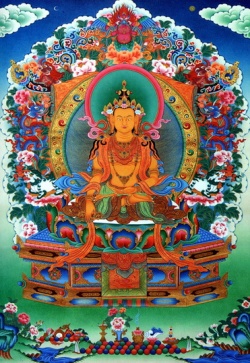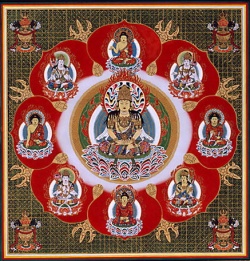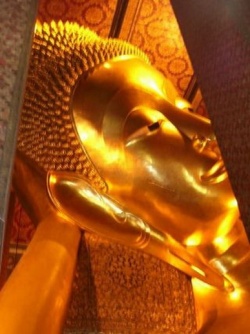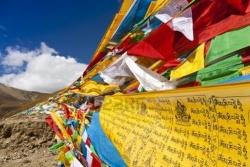Mandala Offering by Yukhok Chatralwa Chöying Rangdrol
OM AH HUNG
One billion universes–a hundred times ten million worlds,
Filled with all the wealth of gods and human beings, like the “seven precious gems”,
My bodies, my possessions, and my sources of merit, all together, I offer them in their entirety, so that
I may be born as a nirmanakaya and turn the wheel of Dharma, liberating all beings!
The highest heaven of great bliss, the realm of “Tukpo Köpa”,
Perfect with the five certainties and the mandala of the five buddha families, and
Inconceivably vast clouds of offerings of every variety of sensual and emotional stimulants—
With this offering, may we enjoy the perfection of the sambhogakaya fields!
Where all appearance and existence are completely pure from the very beginning—the youthful vase body,
Ornamented by the play of dharmata, unceasing compassion,
The realm where all clinging to the perception of kayas and tiklés is naturally liberated—
With this wisdom offering, may we enjoy the freedom of the dharmakaya reality!
Visualize the field of merit in the sky before you, just as in the practice of taking refuge. Then clean the mandala base, which is made from precious metal or some other substance, sprinkle it with scented water and bajung, and arrange heaps of flowers, as described in the texts, as a support for your visualization. Alternatively, if you are not doing this as a daily practice, it is sufficient simply to imagine.
In any case, the ordinary nirmanakaya mandala consists of one hundred times ten million worlds each of which has four continents, Mount Meru, and the realms of the gods. This great buddhafield is filled with all the abundant riches of gods and men, including the seven precious emblems of royalty and so on. Offer especially your own body, possessions and virtues, in their entirety and without hesitation. And think to yourself: “May I obtain nirmanakaya sovereignty, and, through turning the wheel of Dharma, lead beings along the path to liberation and omniscience.”
Then for the extraordinary sambhogakaya mandala, in the space above, consider that the piles represent the five buddha families, complete with the five certainties, in the blissful paradise of Akanishtha-Ghanavyuha, where countless goddesses, such as the goddess of beauty and the rest, offer vast unimaginable clouds of offerings to stimulate the senses. Think: “Through this vast and boundless offering, may we experience the sambhogakaya realms!”
In the sphere above is the special dharmakaya mandala. The naturally arising wisdom of the way things are has always been present as mind’s very nature as the ‘youthful vase body’. Upon the ground of this youthful vase body, the utter purity of all that appears and exists, arrange piles to represent the appearances of pure realms, deities and palaces, purified entirely of any clinging to kayas and tiklés, and arising as ornaments of the display of reality itself, unceasing compassionate energy and the manifestation of clear light. Think: “Through this offering, may we enjoy the realm of the dharmakaya Samantabhadra!”
If you do the practice in brief, you can recite the verse of the seven point mandala: “The ground is purified with scented water and strewn with flowers…etc.”[1] Although this is the nirmanakaya mandala, it is said that since the nirmanakaya is of the nature of the three kayas, this can also be considered a three kaya mandala. Therefore, it is said, it is perfectly sufficient to offer the mandala in this way alone.
Moreover, there are other traditions of explanation, according to which the cosmos of a billion worlds, the Saha world system, is offered to the deities of the nirmanakaya. Then, the inner mandala of one’s own body is offered to the deities of the sambhogakaya. For this, the skin is considered to be the universal golden ground, the blood the sprinkling of perfumed water, the four limbs the four continents, the other parts of the body the subcontinents, the two eyes the sun and moon, and the other objects of the senses the offering goddesses. Finally the secret dharmakaya mandala, in which piles representing the four visions of spontaneous presence are arranged upon the original ground of primordial purity, is offered to the deities of the dharmakaya. Thus, since the various forms of mandala offering that appear in the Ancient Tradition are explained clearly in the relevant texts of the original canonical teachings (kama) and the revelations (terma), you should consult these sources.
In addition, there is the ‘thirty-seven point mandala offering’ composed by Chögyal Phakpa, the Sakyapa Protector of Beings, which is widely renowned. The master Buddhaguhya taught a thirteen point mandala offering according to the tradition of yoga tantra, which consists of Mount Meru, the four continents and the [eight] subcontinents. The master Jetari[2] described a seventeen point offering, in which the sun and moon, and the parasol and victory banner are added to the four continents, eight subcontinents and Mount Meru. The master Manjushrikirti spoke of a twenty-three point offering, in which the seven emblems of royalty, the vase of treasure and the sun and moon are offered in addition to Mount Meru and the continents and subcontinents. The tradition of the Kalachakra Tantra includes a twenty-five point mandala which, in addition to these twenty-three, features [the planets] Rahu and Ketu.
In the thirteen point mandala the piles for the sun and moon are omitted. In the seventeen point version the parasol and victory banner appear in the south and north. In the twenty-three point version the seven emblems of royalty and the treasure vase are added in the cardinal and intermediate directions, and the sun and moon appear in the east and west. In the twenty-five point version the planets Rahu and Ketu are added in the south and north. This is how it is explained.
| Translated by Adam Pearcey, Rigpa Translations, 2006 (revised 2012). Thanks to Ringu Tulku Rinpoche for his clarifications.
Main
The ground is purified with scented water and strewn with flowers
It is adorned with Sumeru, the king of mountains, the four quarters of the universe, and the sun and the moon;
Thinking of it as the blessed buddha-fields, I offer it.
By virtue of this offering, may all beings here and now attain the happiness of that pure land!
TRAM GURU RATNA MANDALA PUDZA MEGHA SAMUDRA SAPARANA SAMAYE AH HUNG ↩
ཛེ་ཏ་རི་དགྲ་ལས་རྣམ་པར་རྒྱལ་བ་. ↩



